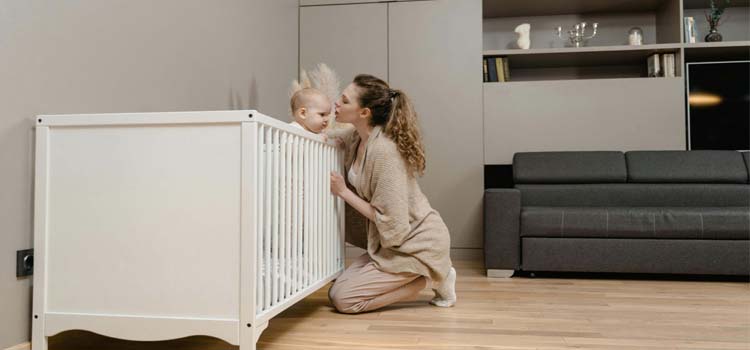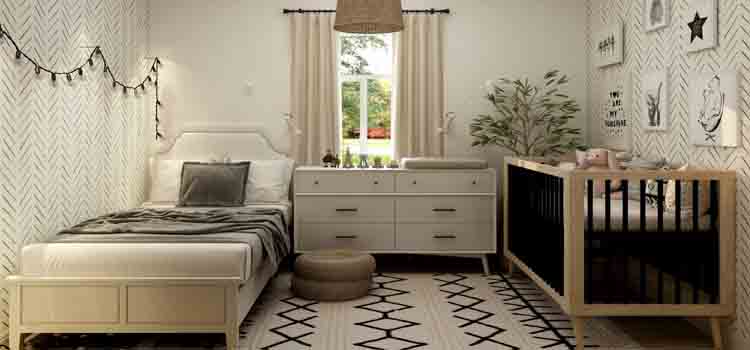As an Amazon Associate I earn from qualifying purchases.
Are you a parent-to-be or a concerned caregiver wondering about the safety and durability of your baby’s crib? Understanding the weight capacity of a crib is crucial for ensuring your little one’s safety and peace of mind. In this comprehensive guide, we delve into the vital question: how much weight can a crib hold?
We provide all the information you need to make an informed choice about your baby’s sleeping environment, from examining industry standards to practical factors. Come along as we walk you through the nuances of crib weight restrictions, giving you the tools to provide a safe and cozy environment for your priceless child.
So, let’s dive in and unravel the mysteries surrounding crib weight capacities, ensuring a snug and secure haven for your little one’s sweet dreams.

Understanding Crib Safety for Your Baby
As caregivers or expectant parents, your priority is ensuring your child is safe and healthy. A haven where your kid will spend many hours sleeping and resting, the crib stands out among many baby accessories and nursery necessities. But with safety issues hanging over us, it becomes crucial to comprehend the nuances of crib safety.
Crib safety is more than simply a matter of convenience or preference; it is an essential component of newborn care that directly impacts your baby’s health and safety. According to the American Academy of Pediatrics (AAP), a safe sleep environment is critical for lowering the incidence of Sudden Infant Death Syndrome (SIDS) and other sleep-related incidents. As a result, ensuring that your baby’s cot is a haven devoid of any threats is an absolute must.
Being aware of weight restrictions is crucial when it comes to crib safety, among other things. Each crib has a weight capacity indicating the heaviest weight it can securely sustain. Going beyond this limit puts your baby’s safety at serious risk and jeopardizes the crib’s structural integrity. Consequently, educating yourself on crib weight limits and strictly following them to give your child a safe and secure sleeping environment is essential.
Factors Affecting Crib Weight Capacity
Several factors influence a crib’s weight capacity:
Materials and Construction
Cribs are made of various materials, including wood, metal, or a combination. The crib’s weight capacity mostly depends on how sturdy and long-lasting these materials are. The design and construction methods may also affect the crib’s total strength.
Proper Mattresses and Bedding
The mattress support system, which consists of mattress springs and a frame, helps the crib’s weight-bearing capacity.
Select a firm, well-fitting mattress that complies with safety regulations to lessen the possibility of suffocation or entrapment. Soft toys, pillows, and extra blankets should not be used in the crib as they can suffocate the baby.
The stability and safety of the crib are improved by an equally distributed weight distribution system that is strong and well-designed.
Adherence to Safety Standards
Credible crib producers follow the strict safety guidelines the American Society for Testing and Materials (ASTM) and the Consumer Product Safety Commission (CPSC) set forth. Adherence to these guidelines guarantees that cribs fulfill essential safety criteria, such as maximum weight capacities.
Typical Crib Weight Limits

While specific weight limits may vary between crib models, there are general guidelines to consider:
- Standard Cribs: Most typical cribs have a weight limit of 35-50 pounds. This level normally accommodates infants and toddlers aged two to three.
- Convertible Cribs: Convertible cribs, which convert into toddler or full-size beds, frequently feature higher weight limits. Depending on the model and arrangement, these cribs may sustain weights of up to 100 pounds or more.
- Mini Cribs: Mini cribs are designed for smaller spaces and usually have lower weight limits than standard cribs. Weight limits for mini cribs typically range from 25 to 40 pounds.
- Portable Cribs: Portable or travel cribs, designed for on-the-go use or in small living spaces, typically feature lower weight limitations than normal cribs. These cribs emphasize lightweight design and portability above heavy-duty weight capacity, often accommodating 30 to 40 pounds.
How to Determine a Crib’s Weight Capacity
Before placing your infant in their crib, determine their weight capacity. But how do you appropriately analyze this? Begin by consulting the manufacturer’s specifications and user manuals. These documents often contain thorough information regarding the crib’s weight limits and special guidelines for individual components.
Understanding the weight limits for each crib component is also critical. This includes the mattress, support system, and other accessories or attachments. Being aware of these constraints guarantees that your baby’s crib remains structurally sound and safe.
Consider using some practical strategies to guarantee that weight limitations are met. Avoid overloading the crib with heavy goods, and Make sure to inspect it regularly for any indications of wear or damage.
Ensuring Crib Safety (How Much Weight Can A Crib Hold)
Ensuring your baby’s safety is paramount regardless of the crib’s weight limit. Here are essential safety tips to follow:
Follow Manufacturer Guidelines
Always follow the manufacturer’s assembly, use, and weight limits instructions. These rules are intended to maximize safety while minimizing the possibility of accidents or injuries.
Choose a Quality Mattress
Choose a firm, well-fitting mattress that passes safety specifications. A good mattress not only gives comfort but also encourages safe sleep by decreasing the danger of suffocation or Sudden Infant Death Syndrome (SIDS).
Regularly Inspect the Crib
Check the crib regularly for indications of wear, damage, or loosening hardware. As soon as possible, take care of any problems to avoid danger and increase the crib’s longevity. To preserve structural integrity, make sure that all screws, bolts, and other parts are tightened all the way.
Avoid Overloading the Crib
Avoid throwing the crib to the brim with extra toys, blankets, or accessories. These objects may weigh more than the crib can support and present a suffocation risk.
Monitor Your Baby
To make sure your child stays within the weight capacity and safety constraints of the crib:
- Monitor their weight and developmental milestones.
- When kids outgrow the crib or get too big for it, move up to a bigger bed.
- Keep an eye on your child using a baby monitor and act quickly if they show any signs of discomfort or distress.
Conclusion (How Much Weight Can A Crib Hold)
We must stress again how crucial it is to comprehend this component of crib safety as we wrap up our investigation of crib weight capacity. Determining a crib’s weight limit is important for your child’s safety and wellbeing, not merely to comply with regulations.
Understanding the weight restrictions on your baby’s crib allows you to establish a secure resting space proactively. With this information, you may choose a crib sensibly and use it for the intended purpose.
The most important thing should always be your baby’s safety. Let’s pledge as parents and caregivers to put safety first while selecting and using a crib. By adhering to safety regulations, being aware of the crib’s weight capacity, and routinely checking it for wear or damage, we can provide our babies with the safe and nurturing sleep environment they need.
Nothing is more valuable than your child’s wellbeing, so act now to prioritize their safety.
FAQs (How Much Weight Can A Crib Hold)
No, cribs are designed to support the weight of babies or young children, not adults.
The weight capacity of cribs varies, but it typically ranges from 30 to 50 pounds, depending on the model and design.
No, cribs are not designed for adults, and attempting to get into one can be dangerous and potentially damaging.
Standard crib weight limits normally fall between 35 and 50 pounds, though manufacturer-specific weight limits may apply.
Amazon and the Amazon logo are trademarks of Amazon.com, Inc, or its affiliates.
Leave a Reply